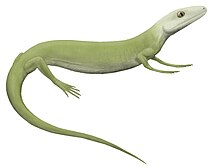Protorothyrididae
Appearance
| Protorothyridids Temporal range: Pennsylvanian-Asselian,
| |
|---|---|

| |
| Life restoration of Protorothyris archeri | |
| Scientific classification | |
| Domain: | Eukaryota |
| Kingdom: | Animalia |
| Phylum: | Chordata |
| Class: | Reptilia |
| Clade: | Eureptilia |
| Family: | †Protorothyrididae Price, 1937 |
| Type species | |
| †Protorothyris archeri Price, 1937
| |
Protorothyrididae is an extinct family of small, lizard-like reptiles. Their skulls did not have fenestrae, as is also true of modern turtles and tortoises. Protorothyridids lived from the Late Carboniferous to Early Permian periods, in what is now North America.[1][2][3][4] Many genera of primitive reptiles were thought to be protorothyridids. Brouffia, Coelostegus, Paleothyris and Hylonomus, for example, were recently found to be more basal eureptiles.[5]
References
- ^ "Two new cotylosaurs from the Permian of Texas". Proceedings of the New England Zoölogical Club. 11: 97–102. 1937.
{{cite journal}}: Cite uses deprecated parameter|authors=(help) - ^ "Late Pennsylvanian and Early Permian Vertebrates of the Pittsburgh-West Virginia Region". Annals of Carnegie Museum. 33: 47–113. 1952.
{{cite journal}}: Cite uses deprecated parameter|authors=(help) - ^ "The Pennsylvanic Amphibia of the Mazon Creek, Illinois, Shales". Kansas University Science Bulletin. 6 (2): 232–259. 1912.
{{cite journal}}: Cite uses deprecated parameter|authors=(help) - ^ "Carboniferous Stem-Reptiles of the Family Romeriidae". Bulletin of the Museum of Comparative Zoology. 143 (5): 321–363. 1972.
{{cite journal}}: Cite uses deprecated parameter|authors=(help) - ^ Müller, J.; Reisz, R. R. (2006). "The phylogeny of early eureptiles: comparing parsimony and Bayesian approaches in the investigation of a basal fossil clade". Systematic Biology. 55 (3): 503–511. doi:10.1080/10635150600755396. PMID 16861212.





